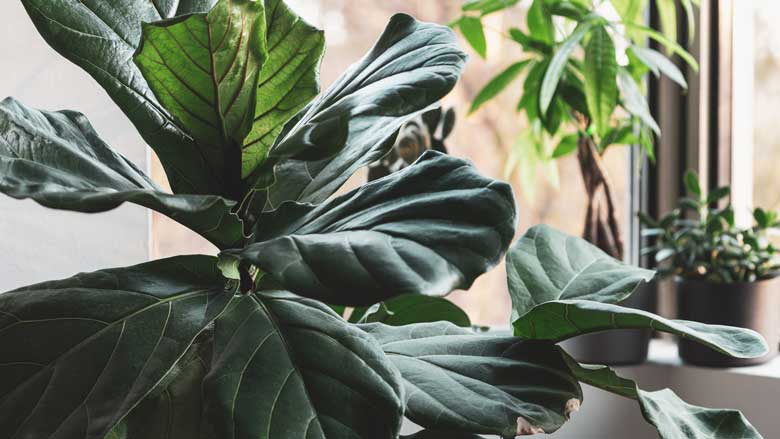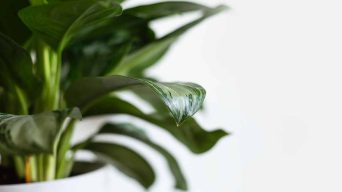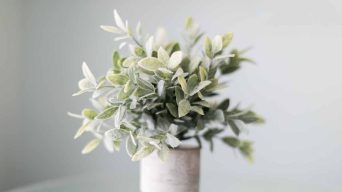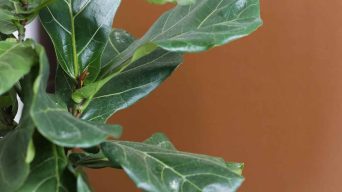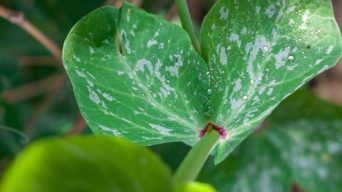Houseplants are a great way to bring life and color into your home.
They can, however, be susceptible to various problems.
One common issue is brown spots on the leaves.
There are a few possible causes of brown spots on houseplant leaves.
Although most are not severe, it is essential to diagnose the problem correctly so that you can treat it appropriately.
Here are some of the most common causes of brown spots on houseplant leaves and some tips on how to treat them.
What Causes Brown Spots on Houseplant Leaves and How To Treat Them
Houseplants can develop brown spots on their leaves for a variety of reasons.
The problem is not severe and can be easily resolved in most cases.
Here are some of the most common causes of brown spots on houseplant leaves:
1. Too Much Direct Sunlight
Brown spots on houseplant leaves can be caused by too much sun exposure.
The leaves of most houseplants are not accustomed to direct sunlight, and the intense heat and light can easily damage them.
Brown spots are usually the result of leaf scorch, which occurs when the leaves are exposed to direct sunlight for extended periods.
Leaf scorch can cause the leaves to turn brown and dry out, eventually leading to plant death.
How To Tell If Your Plant Has Leaf Scorch
If you suspect that your plant has leaf scorch, there are a few tell-tale signs to look for. These include:
- Brown patches or spots on the leaves
- Leaves that are dry or crispy to the touch
- Leaves that are discolored or faded in appearance
- Leaves that are falling off the plant
How To Treat Leaf Scorch
If you think your plant has leaf scorch, the first thing you should do is move it to a location that receives indirect or filtered sunlight.
You may also need to cut back on the amount of time the plant is exposed to direct sunlight each day.
In some cases, you may need to provide shade for your plant during the hottest hours of the day.
2. Underwatering
Another common cause of brown spots on houseplant leaves is underwatering.
When plants are not watered properly, their leaves can begin to turn brown and wilt.
This is often the result of a plant being too dry.
If the soil around your plant is dry to the touch, likely, that your plant is not getting enough water.
Underwatering happens more often than overwatering, as it is easy to forget to water plants regularly.
To avoid underwatering your plants, sticking to a watering schedule is essential.
Depending on the type of plant, you will need to water it every one to two weeks.
How To Tell If Your Plant Is Underwatered
There are a few signs that you can look for to determine if your plant is not getting enough water.
These include:
- Brown patches or spots on the leaves, especially at the edges or on leaf tips.
- Leaves that are drooping or wilted
- Dry, crumbly soil
How To Treat Underwatered Plants
If you think your plant is not getting enough water, you should first water it thoroughly.
Be sure to soak the soil until water runs out of the drainage holes at the bottom of the pot.
Once the plant has been watered, stick to a regular watering schedule to prevent the problem from happening again.
3. Overwatering
Overwatering is a common problem for houseplants, and it can cause several issues, including brown spots on leaves.
The roots of a plant need oxygen to function properly, and when the soil is constantly wet, the roots don’t get the chance to dry out, and they suffocate.
This lack of oxygen causes the leaves to turn brown and die.
In addition, overwatering can lead to fungal growth, further damaging the plant.
Overwatering usually happens when plants are given too much water or when the pot doesn’t have adequate drainage.
It is essential to water your plants only when the soil is dry to the touch to avoid these problems.
How To Tell If Your Plant Is Overwatered
There are a few signs that you can look for to determine if your plant is being overwatered.
These include:
- Brown patches or spots on the leaves
- Yellowing of the leaves
- Leaves that are wilted or drooping
- Soil that is soggy or mushy
How To Treat Overwatered Plants
If you think your plant is being overwatered, you should stop watering it and allow the soil to dry out completely.
Once the soil is dry, you can resume watering your plant on a regular schedule.
Be sure to water only when the soil is dry to the touch to avoid overwatering in the future.
3. Lack of Humidity
Another common cause of brown leaf spots on indoor plants is a lack of humidity.
Most houseplants come from tropical or subtropical regions where the air is very humid.
When these plants are brought into a home, they often struggle to adjust to drier conditions.
This can cause their leaves to turn brown and dry out.
How To Tell If Your Plant Needs More Humidity
There are a few signs that you can look for to determine if your plant needs more humidity.
These include:
- Brown leaf tips
- Leaves that are dry or crispy to the touch
- Leaves that are discolored or faded in appearance
- Plant stems that are brittle
How To Treat Plants That Need More Humidity
If you think your plant needs more humidity, you can do a few things to help.
First, you can mist your plant with water every day to help increase the moisture around it.
You can also place your plant on a pebble tray, which is a tray filled with rocks and water.
The water will evaporate and help to increase the humidity around your plant.
Finally, you can group your plants to create a mini-greenhouse effect.
This will help trap moisture in the air and keep your plants healthy and happy.
4. Fertilizer Issues
Fertilizer can also be a cause of brown spots on houseplant leaves.
If a plant is given too much fertilizer, the excess nutrients can build up in the soil and cause the leaves to turn brown.
This is often the result of using a too strong fertilizer for the plant.
It can also happen if you fertilize more often than necessary.
It is essential only to fertilize your plants when they are actively growing to avoid this problem.
This is usually in the spring and summer. In addition, you should use a fertilizer that is specifically designed for houseplants.
How To Tell If Your Plant Has Fertilizer Burn
There are a few signs that you can look for to determine if your plant has fertilizer burn.
These include:
- Brown leaf tips or edges
- Yellowing of the leaves
- Leaves that are wilted or drooping
How To Treat Plants With Fertilizer Burn
If you think your plant has fertilizer burn, the first thing you should do is stop fertilizing it.
Once the leaves have recovered, you can resume fertilizing your plant regularly.
Be sure to use a fertilizer specifically designed for the type of plant you have.
5. Cold Temperature
Another common cause of brown spots on indoor plant leaves is cold temperatures.
If a plant is exposed to too low temperatures, the leaves can turn brown and die.
This is often the result of placing a plant near a drafty window or in a too cold room.
It is essential to ensure that your plants are not exposed to temperatures below 50 degrees Fahrenheit to avoid this problem.
How To Tell If Your Plant Is Too Cold
There are a few signs that you can look for to determine if your plant is too cold.
These include:
- Light brown or yellow spots on the leaves
- Leaves that are wilted or drooping
- Brittle stems
How To Treat Plants That Have Been Exposed To Cold
If your plant has been exposed to cold temperatures, there are a few steps that you can take to try and save it.
These include:
- Move the plant to a warmer location
- Add a layer of mulch around the base of the plant
- Cover the plant with a cloth or plastic sheet
- Place a humidifier near the plant
6. Pest Infestation
Another common cause of brown spots on houseplant leaves is a pest infestation.
If your plant is infested with pests, they can cause the leaves to turn brown and cause other damage.
The most common pests that attack houseplants are spider mites, mealybugs, aphids, thrips, and scale insects.
Spider Mite Damage
Spider mites are tiny, spider-like pests that feed on the sap of plants.
They are most common in dry, warm conditions.
If your plant is infested with spider mites, you will see small webs on the leaves and stems.
The leaves will also have small brown spots where the mites have been feeding.
Mealybug Damage
Mealybugs are tiny, white, fuzzy pests that feed on the sap of plants.
They are most common in humid conditions.
If your plant is infested with mealybugs, you will see small white bugs on the leaves and stems.
The leaves will also have small brown spots where the bugs have been feeding.
Aphid Damage
Aphids are small, green, or black pests that feed on the sap of plants.
They are often found on the undersides of leaves and can cause brown spots to form.
To treat aphid damage, start spraying the plant with water to remove the pests.
If your plant is infested with aphids, you will see small, green, or black bugs crawling on the undersides of the leaves.
You may also see a sticky substance on the leaves.
Thrips Damage
Thrips are tiny, winged insects that are attracted to light-colored flowers.
They feed by puncturing the plant surface and sucking out the juices.
This feeding damage causes silver or brownish streaks on the leaves, and if the population is high enough, it can stunt the plant’s growth.
If your plant is infested with thrips, you will see the insects themselves crawling on the leaves or flying around the plant.
Scale Insect Damage
Scale insects are one of the most common pests that attack houseplants.
They are small, wingless creatures that feed on plant sap.
They excrete a sticky substance called honeydew, attracting ants and other insects.
Scale insects can weaken a plant and cause it to produce yellow or brown leaves.
You can tell if your plant has scale insects if you see small, brown bumps on the leaves or stems.
If you see honeydew, that is another sign that your plant has scale insects.
How To Treat Pest Infestation
If your plant is infested with pests, there are a few steps that you can take to try to remove them.
These include:
- Remove the pests by hand. Use a cotton swab or a soft brush to remove the pests from the plant.
- Spray the plant with water. This will remove some of the pests from the plant.
- Use insecticidal soap or neem oil. These products are safe for use on houseplants and can help to kill the pests.
- Apply horticultural oil. This will smother the pests and can help to control infestations.
7. Diseases
Diseases are another common cause of brown spots on houseplant leaves.
Some of the most common diseases that affect houseplants are:
Bacterial Leaf Spot
Bacterial leaf spot is a common disease that affects many types of houseplants.
This disease is caused by bacteria that enter the plant through wounds in the leaves.
The bacteria then multiply and cause brown spots to form on the leaves.
The spots are often surrounded by a yellow halo.
The best way to treat bacterial leaf spot is to remove the affected leaves and destroy them.
You can also treat the plant with a bactericide.
Fungal Leaf Spot
Fungal leaf spot is another common disease that affects many types of houseplants.
A variety of different fungi causes this disease, and it manifests as brown or black spots on the leaves of the plant.
The spots may be circular or irregular in shape, and a yellow halo often surrounds them.
Fungal leaf spot is most commonly seen in plants grown in humid conditions, such as greenhouses or homes with poor ventilation.
The fungi that cause this disease thrive in warm, moist environments, so keeping your houseplants in a well-ventilated area is important.
The best way to treat the fungal leaf spot disease is to remove the affected leaves from the plant.
You can also try spraying the plant with a fungicide.
It is essential to water your plants at the base rather than from above to prevent this fungal disease.
This will help keep the leaves dry, making it more difficult for the fungi to infect the plant.
Anthracnose
Anthracnose is a disease that affects many types of plants, including houseplants.
This disease is characterized by brown spots on the leaves of the plant.
The spots may be circular or irregular in shape and can range in size from a few millimeters to several centimeters.
Anthracnose is caused by a fungus that lives on the surface of the plant’s leaves.
This fungus thrives in warm, humid conditions and can spread quickly from one plant to another.
The best way to treat anthracnose is to remove any affected leaves from the plant.
You should also increase the ventilation in the area where the plant is growing and reduce the amount of water you give the plant.
If you see any brown spots on your plant’s leaves, you should remove the affected leaves immediately.
Rust
Rust can be a plant disease that affects many different types of plants, including houseplants.
It usually appears as orange or brown spots on the leaves of a plant.
Several different fungi can cause rust, and it is often difficult to control.
This disease is more common in humid or wet conditions.
To treat rust on your houseplants, you will need to remove the affected leaves.
You can also try using a fungicide to control the disease.
Be sure to follow the directions on the label carefully. If the rust is severe, you may need to throw away the plant.
The best way to prevent rust is to water your plants from the bottom so that the leaves stay dry.
You should also remove any dead leaves or debris from around the plant so that the fungi cannot spread.
Stem and Root Rot
Most houseplants are susceptible to stem and root rot caused by several fungi.
These fungi live in the soil and attack the plant through the roots.
Stem and root rot symptoms include brown or black spots on the leaves, wilting, and yellowing.
The best way to treat stem and root rot is to replant the affected plant in a fresh, sterile potting mix.
You can also try using a fungicide, but these are often not very effective. If your plant is heavily infected, it may need to be thrown away.
Preventing stem and root rot is the best way to deal with this problem.
Make sure you choose a well-draining potting mix that doesn’t stay soggy.
Avoid overwatering your plants, and don’t let them sit in water.
If you suspect your plant has stem and root rot, replant it in fresh soil as soon as possible.
How to Prevent Brown Spots on Indoor Plant Leaves
Preventing brown spots on indoor plant leaves is key to keeping your plants healthy and looking their best.
There are a few simple steps you can take to prevent this problem:
- Water your plants regularly. Brown spots can be caused by too much or too little water. Watering your plants on a regular schedule will help them stay healthy and prevent brown spots.
- Avoid overwatering. Overwatering can cause brown spots on leaves and other problems such as root rot. Be sure to check the soil before watering and only water when the soil is dry.
- Provide good drainage. Good drainage is essential for preventing brown spots on leaves. Be sure to use a pot with drainage holes and add gravel or other materials to the bottom of the pot to help with drainage.
- Avoid direct sunlight. Direct sunlight can cause brown spots on leaves, so be sure to place your plants in an area that receives indirect light.
- Prune regularly. Pruning helps remove dead or dying leaves, which can cause brown spots. Prune your plants regularly to keep them healthy and prevent brown spots.
- Place your plants in a well-ventilated area. Good air circulation will help prevent brown spots on leaves by allowing the plant to dry out quickly after watering.
- Keep your plants clean. Dust and dirt can build up on leaves and cause brown spots. Regularly wipe your plants down with a damp cloth to remove dust and dirt.
- Provide adequate humidity. Dry air can cause brown spots on leaves, so provide good humidity for your plants. This can be done by regularly placing a humidifier in the room or misting the plants.
- Avoid fertilizing too often. Over-fertilizing can cause brown spots on leaves. Only fertilize your plants during the growing season and follow the instructions on the fertilizer label.
- Inspect your plants regularly. Check your plants often for brown spots or other problems. If you catch a problem early, it will be easier to treat.
By following these simple tips, you can prevent brown spots on indoor plant leaves and keep your plants healthy and looking their best.
Final Thoughts
Houseplants are susceptible to several different diseases and pests.
Some of the most common problems include brown spots on leaves, wilting, and yellowing.
The best way to prevent these problems is to water your plants regularly, provide good drainage, and avoid overwatering.
If you notice a problem, be sure to inspect your plant carefully and take appropriate action to prevent the problem from spreading.
With a bit of care and attention, you can keep your plants healthy and looking their best.

